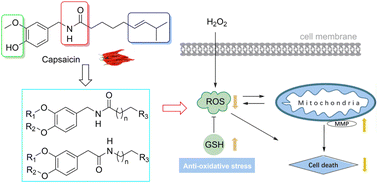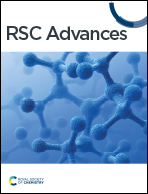Synthesis and biological evaluation of capsaicin analogues as antioxidant and neuroprotective agents†
Abstract
Capsaicin and its analogues 3a–3q were designed and synthesized as potential new antioxidant and neuroprotective agents. Many analogues exhibited good antioxidant effects, and some showed more potent free radical scavenging activities than the positive drug quercetin (IC50 = 8.70 ± 1.75 μM for DPPH assay and 13.85 ± 2.87 μM for ABTS assay, respectively). The phenolic hydroxyl of capsaicin analogues was critical in determining antioxidant activity. Among these compounds, 3k displayed the most potent antioxidant activity. Cell vitality tests revealed that the representative compound 3k was good at protecting cells from H2O2-induced oxidative damage at low concentrations (cell viability increased to 90.0 ± 5.5% at 10 μM). In addition, the study demonstrated that 3k could reduce intracellular ROS accumulation and increase GSH levels to prevent H2O2-induced oxidative stress in SY5Y cells. In the mitochondrial membrane potential assay, 3k significantly increased the MMP level of SY5Y cells treated with H2O2 and played an anti-neuronal cell death role. These results provide a promising strategy to develop novel capsaicin analogues as potential antioxidant and neuroprotective agents.



 Please wait while we load your content...
Please wait while we load your content...